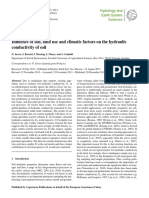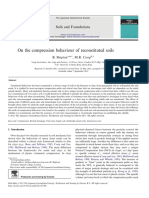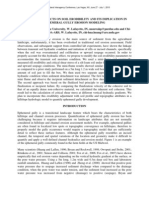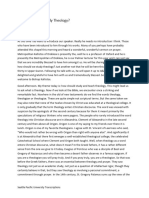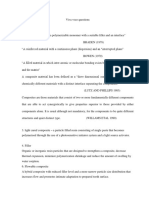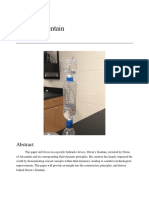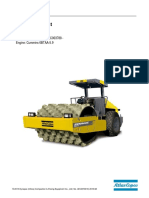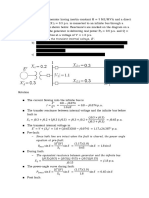Soil Temperature
Soil Temperature
Uploaded by
Vali GheorghisorCopyright:
Available Formats
Soil Temperature
Soil Temperature
Uploaded by
Vali GheorghisorCopyright
Available Formats
Share this document
Did you find this document useful?
Is this content inappropriate?
Copyright:
Available Formats
Soil Temperature
Soil Temperature
Uploaded by
Vali GheorghisorCopyright:
Available Formats
Soil Temperature Changes with Time and Depth: Theory, D.L.
Nofziger
Introduction Model Simplifications FAQ Glossary Bibliography and Contributors
Soil Temperature Variations With Time and Depth Soil temperature fluctuates annually and daily affected mainly by variations in air temperature and solar radiation. The annual variation of daily average soil temperature at different depths can be estimated using a sinusoidal function (Hillel, 1982; Marshall and Holmes, 1988; Wu and Nofziger, 1999). This program estimates daily soil temperatures and displays these values as functions of time or depth for user defined input parameters. Model Description The annual variation of daily average soil temperature at different depths is described with the following sinusoidal function ( Hillel, 1982):
where T(z,t) is the soil temperature at time t (d) and depth z (m), T a is the average soil temperature (oC), A0 is the annual amplitude of the surface soil temperature (oC), d is the damping depth (m) of annual fluctuation and t0 is the time lag (days) from an arbitrary starting date (taken as January 1 in this software) to the occurrence of the minimum temperature in a year. The damping depth is given by d = (2D h/ )1/2, where Dh is the thermal diffusivity and = 2 /365 d-1 . Assumptions and Simplifications The sinusoidal temperature model was derived by solving the following partial differential equation ( Hillel, 1982 ; Marshall and Holmes, 1988):
where T(z,t) is the soil temperature at time t and depth z and Dh is the thermal diffusivity.
file:///C|/SoilPhysics/software/SoilTemperature/document.html (1 of 8)2/16/2005 4:52:46 PM
Soil Temperature Changes with Time and Depth: Theory, D.L. Nofziger
The following assumptions are employed in the derivation of the temperature model: 1. A sinusoidal temperature variation at the soil surface z = 0. That is
where Ta is the average soil temperature, A0 is the amplitude of the annual temperature function, t0 a time lag from an arbitrary starting date (selected as January 1 in this software) to the occurrence of the minimum temperature in a year. 2. At infinite depth, the soil temperature is constant and is equal to the average soil temperature. 3. The thermal diffusivity is constant throughout the soil profile and throughout the year. Frequently Asked Questions 1. How well does the model predict soil temperatures? Figure 1 compares measured and predicted soil temperatures at 4 depths for a site (located at 36.87 degrees North and 115.57 degrees East) in Hebei Province, China (Wu and Nofziger, 1999). The parameters in the model in this case were obtained from measured soil surface temperatures, clay content and average water content of each layer. Clearly the model does a good job predicting the mean daily temperatures.
file:///C|/SoilPhysics/software/SoilTemperature/document.html (2 of 8)2/16/2005 4:52:46 PM
Soil Temperature Changes with Time and Depth: Theory, D.L. Nofziger
Figure 1. Measured mean and predicted soil temperatures at four depths based on measured soil surface temperatures.
2. Can I use air temperatures to estimate soil temperatures? Figure 2 compares the measured and predicted soil temperatures for the same site when model parameters are obtained from air temperatures instead of measured soil surface temperatures (Wu and Nofziger, 1999). The model consistently underestimates soil temperatures by about 2 degrees Celsius. These data and those of others suggests that good estimates of temperatures under bare soils can be obtained using by simply increasing the maximum and minimum air temperatures by 2 degrees when defining the model parameters. The correction for soils that are not bare will likely be less since those soil temperatures are somewhat less due to shading from the plants.
file:///C|/SoilPhysics/software/SoilTemperature/document.html (3 of 8)2/16/2005 4:52:46 PM
Soil Temperature Changes with Time and Depth: Theory, D.L. Nofziger
Figure 2. Comparison of measured and predicted soil temperatures at four depths based upon air temperatures at the site.
3. What is the effect of soil wetness on soil temperature distributions? The thermal diffusivity of the soil is the ratio of the thermal conductivity of the soil to the volumetric heat capacity of the soil. The conductivity and volumetric heat capacity increase with water content so the diffusivity is also dependent upon soil water content. For mineral soils, the thermal diffusivity increases with water content at low water contents and then gradually decreases with increasing water contents at high water contents. This is illustrated in the Figure 3 for three clay contents and for three bulk density values. The volumetric heat capacity fot the three bulk densities is shown in Figure 4.
file:///C|/SoilPhysics/software/SoilTemperature/document.html (4 of 8)2/16/2005 4:52:46 PM
Soil Temperature Changes with Time and Depth: Theory, D.L. Nofziger
file:///C|/SoilPhysics/software/SoilTemperature/document.html (5 of 8)2/16/2005 4:52:46 PM
Soil Temperature Changes with Time and Depth: Theory, D.L. Nofziger
Figure 3. Variation of thermal conductivity and diffusivity with soil water content, clay content, and bulk density for mineral soils.
Figure 4. Volumetric heat capacity for three bulk densities for soils whose thermal conductivity and diffusivity are shown in Figure 3.
The impact of water content upon estimated soil temperature can be observed by viewing results for this range of thermal diffusivities. Figure 3 is based on research cited by of deVries (1963, 1975) and Farouki (1986). Heat transport involves soils as a mixture of mineral particles (primarily quartz and clay), organic matter, water, and air. For a mineral soils, contributions of organic matter and air to specific heat capacity and thermal conductivity of the composite soil system are usually negligible. Thermal diffusivity values change by approximately 30% or less for water contents greater than 0.05 m3 m-3. Glossary
file:///C|/SoilPhysics/software/SoilTemperature/document.html (6 of 8)2/16/2005 4:52:46 PM
Soil Temperature Changes with Time and Depth: Theory, D.L. Nofziger
Amplitude: Amplitude is a parameter characterizing the annual variation of soil temperature around an average value. If the variation in temperature within a day is averaged out over many years, the annual amplitude is one-half the difference between this annual averaged maximum and annual averaged minimum temperatures within a year. Damping depth: Damping depth is a constant characterizing the decrease in amplitude with an increase in distance from the soil surface. It is defined as (2Dh/)1/2, where D h is the thermal diffusivity and is the frequency of a temperature fluctuation. For annual fluctuation =2 /365 d-1. Thermal diffusivity: Thermal diffusivity is the change in temperature produced in a unit volume by the quantity of heat flowing through the volume in unit time under a unit temperature gradient. It can be calculated from thermal conductivity and volumetric heat capacity. Time lag: Time lag is the number of days from an arbitrary starting date to the occurrence of the minimum temperature in a year. Bibliography deVries, D. A., 1963. Thermal Properties of Soils. In W.R. van Wijk (ed.) Physics of Plant Environment. North-Holland Publishing Company, Amsterdam. de Vries, D. A. 1975. Heat Transfer in Soils. In D.A. de Vries and N.H. Afgan (ed.) Heat and Mass Transfer in the Biosphere. Pp.5-28. Scripta Book Co., Washington, DC. Farouki, O.T. 1986. Thermal Properties of Soils. Series on rock and soil mechanics. Vol. 11. Trans Tech Publ., Clausthal-Zellerfeld, Germany. Hillel, D. 1982. Introduction to soil physics. Academic Press, San Diego, CA. Marshall, T. J. and J. W. Holmes 1988. Soil Physics. 2nd ed. Cambridge Univ. Press, New York. Wu, J. and D. L. Nofziger 1999. Incorporating temperature effects on pesticide degradation into a management model. J. Environ. Qual. 28:92-100. Contributors This program was designed by Dr. D. L. Nofziger and Dr. J. Wu, Research Associate,
file:///C|/SoilPhysics/software/SoilTemperature/document.html (7 of 8)2/16/2005 4:52:46 PM
Soil Temperature Changes with Time and Depth: Theory, D.L. Nofziger
Department of Plant and Soil Sciences, Oklahoma State University, Stillwater, OK 74078. Send email to dln@okstate.edu Last Modified: October 21, 2003.
file:///C|/SoilPhysics/software/SoilTemperature/document.html (8 of 8)2/16/2005 4:52:46 PM
You might also like
- Spy Catcher - Peter WrightDocument337 pagesSpy Catcher - Peter WrightGebeyehu Aragaw Tsegaw100% (6)
- Feasibility of Tapping Atmospheric Charge As A Power Source PDFDocument7 pagesFeasibility of Tapping Atmospheric Charge As A Power Source PDFRooakhNo ratings yet
- The Aspects of GENE THERAPYDocument12 pagesThe Aspects of GENE THERAPYJasmin Prindiana100% (8)
- CORONA With Peek S Law PDFDocument127 pagesCORONA With Peek S Law PDFEmilio ClavelNo ratings yet
- Lista Preturi HALTON RomaniaDocument52 pagesLista Preturi HALTON RomaniaVali GheorghisorNo ratings yet
- Soil PropertiesDocument150 pagesSoil PropertiesJérémy LerondNo ratings yet
- Thermal Resistivity Tests June 26 June 2016Document5 pagesThermal Resistivity Tests June 26 June 2016AliAl-naqaNo ratings yet
- Soil Physics ExerciseDocument14 pagesSoil Physics ExerciseChanako DaneNo ratings yet
- 2.soil Physics IDocument32 pages2.soil Physics ISilvio GumiereNo ratings yet
- Soil Physics Exp: 1. To Study The Relationship Between The Physical Properties of Soil and DepthDocument3 pagesSoil Physics Exp: 1. To Study The Relationship Between The Physical Properties of Soil and DepthAamir khanNo ratings yet
- Factors Affecting The Distribution of Wind Energy On The Surface of EarthDocument1 pageFactors Affecting The Distribution of Wind Energy On The Surface of EarthAkhil KotadiyaNo ratings yet
- UTF-8'en' (Electrical, Control and Communication Engineering) The Causes of The Parameters Changes of Soil ResistivityDocument4 pagesUTF-8'en' (Electrical, Control and Communication Engineering) The Causes of The Parameters Changes of Soil ResistivityFerdianNo ratings yet
- Earthing & Equi Potential BondingDocument27 pagesEarthing & Equi Potential BondingSDE BSS KollamNo ratings yet
- (Tesis) Thermal and Geolelectric Properties of Geomaterials PDFDocument195 pages(Tesis) Thermal and Geolelectric Properties of Geomaterials PDFkikimixplusNo ratings yet
- Basic Electrical Concepts About BusDuctDocument6 pagesBasic Electrical Concepts About BusDuctAshish ThakkarNo ratings yet
- Space Phasor Theory and Control of Multiphase MachinesDocument16 pagesSpace Phasor Theory and Control of Multiphase MachinesvalentinmullerNo ratings yet
- Soil Thermal ConductivityDocument19 pagesSoil Thermal Conductivitymabj68No ratings yet
- Influence of Soil, Land Use and Climatic Factors On The Hydraulic Conductivity of SoilDocument11 pagesInfluence of Soil, Land Use and Climatic Factors On The Hydraulic Conductivity of Soilabi zarkasyiNo ratings yet
- Soil Plant Atmoshere Continuum PDFDocument9 pagesSoil Plant Atmoshere Continuum PDFAnuragNo ratings yet
- Analysis and Performance Assessment of 6-Pulse Inverter-Fed 3 Phase and 6-Phase Induction MachinesDocument8 pagesAnalysis and Performance Assessment of 6-Pulse Inverter-Fed 3 Phase and 6-Phase Induction MachinesEmmanuel Esteban SebanstianNo ratings yet
- On The Compression Behaviour of Reconstituted SoilsDocument14 pagesOn The Compression Behaviour of Reconstituted SoilsRusefFandiNo ratings yet
- Emf Report PDFDocument148 pagesEmf Report PDFUgyenKpNo ratings yet
- Soil Physical Properties - 03!02!2023Document68 pagesSoil Physical Properties - 03!02!2023Gabby ChebetNo ratings yet
- 2A Huang 03 26 10 PaperDocument9 pages2A Huang 03 26 10 PaperReem AlaaNo ratings yet
- Thermal Conductivity of SoilsDocument322 pagesThermal Conductivity of SoilsnavigareeNo ratings yet
- GPH 321-Survey DesignDocument127 pagesGPH 321-Survey DesignAdarta MuhNo ratings yet
- Reduction of Earth Resistance Using Agricultural Waste Materials As Back-Fill PDFDocument22 pagesReduction of Earth Resistance Using Agricultural Waste Materials As Back-Fill PDFsanibubaNo ratings yet
- Review For 100% Renewables SystemsDocument12 pagesReview For 100% Renewables SystemsgustavobarbaranNo ratings yet
- Chapter-1-Intro SoilDocument103 pagesChapter-1-Intro Soilkylle autorNo ratings yet
- Induction Machine ModelDocument9 pagesInduction Machine ModelHernanda BudizNo ratings yet
- Absorption Water Content and Liquid LimitDocument7 pagesAbsorption Water Content and Liquid LimitChandan BleeNo ratings yet
- Induction Motor Equivalent Circuit For Dynamic SimulationDocument6 pagesInduction Motor Equivalent Circuit For Dynamic Simulationmareymorsy2822No ratings yet
- Grain Oriented Electrical Steels: M-2, M-3, M-3X Lite Carlite Goes M-2, M-3, M-4, M-5, M-6 Mill-Anneal GoesDocument47 pagesGrain Oriented Electrical Steels: M-2, M-3, M-3X Lite Carlite Goes M-2, M-3, M-4, M-5, M-6 Mill-Anneal GoesLucio PereiraNo ratings yet
- Estadística. Serie Schaum - 4ta Edición - Murray R. Spiegel PDFDocument66 pagesEstadística. Serie Schaum - 4ta Edición - Murray R. Spiegel PDFCristian Villa SiordiaNo ratings yet
- Machine Simulation ModelsDocument22 pagesMachine Simulation ModelsAshwani RanaNo ratings yet
- Soil Sediment Slug DustDocument6 pagesSoil Sediment Slug Dustsalman ahmed100% (1)
- Chapter 2 Soil-Water-PlantDocument50 pagesChapter 2 Soil-Water-PlantMūssā Mūhābā ZēĒthiopiāNo ratings yet
- Electromagnetic Fields of High-Speed Transportation Systems: The International Maglev BoardDocument22 pagesElectromagnetic Fields of High-Speed Transportation Systems: The International Maglev BoardMayur PuriNo ratings yet
- Plasma Simulation by Artificial Dielectrics and Parallel-Plate Media-Xy9Document14 pagesPlasma Simulation by Artificial Dielectrics and Parallel-Plate Media-Xy9archie222222No ratings yet
- IEEE STD 80-2000 Modelo2capa PDFDocument10 pagesIEEE STD 80-2000 Modelo2capa PDFCristian Daniel Antilao Pizarro100% (1)
- Seasonal Influences On Safety of Substation Grounding SystemsDocument24 pagesSeasonal Influences On Safety of Substation Grounding SystemsDev Kumar100% (1)
- Project ReportDocument30 pagesProject ReportShyam Kumar RastogiNo ratings yet
- Soil Water BalanceDocument9 pagesSoil Water BalanceabiNo ratings yet
- Physics PlasmaDocument17 pagesPhysics PlasmaSarabdeep Singh ChaudhryNo ratings yet
- Water Flow in Saturated Soils Darcy's Law: CE/ENVE 320 - Vadose Zone Hydrology/Soil Physics Spring 2004Document41 pagesWater Flow in Saturated Soils Darcy's Law: CE/ENVE 320 - Vadose Zone Hydrology/Soil Physics Spring 2004joo12345678910No ratings yet
- TP21AEDocument13 pagesTP21AEbogdan darcaciuNo ratings yet
- EMDDocument23 pagesEMDPrakash ArumugamNo ratings yet
- Steady-State Water Flow in Porous Media: Hillel, 1982Document5 pagesSteady-State Water Flow in Porous Media: Hillel, 1982mikiprofaNo ratings yet
- Specific Heat CapacityDocument4 pagesSpecific Heat CapacityJason HenryNo ratings yet
- Electrical Resistivity Survey Forground Water at Eye Zheba Village, Off Bida - Minna RoadDocument5 pagesElectrical Resistivity Survey Forground Water at Eye Zheba Village, Off Bida - Minna RoadIOSRjournal100% (1)
- 1st Mid PartDocument13 pages1st Mid PartAbdullah Al Mamun100% (1)
- Voltage Sag Immunity StandardsDocument4 pagesVoltage Sag Immunity StandardsAmany HamdyNo ratings yet
- Chapter 3 - Physical Properties of SoilDocument50 pagesChapter 3 - Physical Properties of SoilChristian BonoanNo ratings yet
- Newton's Law of ViscosityDocument8 pagesNewton's Law of ViscosityAn FakeihahNo ratings yet
- Simulation Design of Impulse Voltage Generator: Himalayal - Shanghai - ChinaDocument9 pagesSimulation Design of Impulse Voltage Generator: Himalayal - Shanghai - ChinaCRISTIAN ANDRES MAYORGA CASTILLONo ratings yet
- On Line Processing of Xmer OilDocument16 pagesOn Line Processing of Xmer OilrajfabNo ratings yet
- Gravity Geophysical MethodDocument3 pagesGravity Geophysical MethodFebrianto Jeremy AllakNo ratings yet
- Hydrology and Climatology For BSC Forestry StudentsDocument83 pagesHydrology and Climatology For BSC Forestry StudentsMadan ThapaNo ratings yet
- Notes of LessonDocument52 pagesNotes of LessonRichards Ðånte WisdomNo ratings yet
- Chapter 7 Permeability Hydraulic ConductivityDocument73 pagesChapter 7 Permeability Hydraulic Conductivityjoemer cabayaoNo ratings yet
- A Sensitivity Analysis For The Design of Small-Scale Hydropower Plant: Kayabogazi Case StudyDocument11 pagesA Sensitivity Analysis For The Design of Small-Scale Hydropower Plant: Kayabogazi Case Studyramesh subramaniNo ratings yet
- Soil Temperature Profile and Its Readiness For Controlling Buildings Indoors Temperature at Erbil City - Iraqi Kurdistan Region (IKR (Document13 pagesSoil Temperature Profile and Its Readiness For Controlling Buildings Indoors Temperature at Erbil City - Iraqi Kurdistan Region (IKR (Doge IronyNo ratings yet
- Ground Temperature PDFDocument6 pagesGround Temperature PDFceja003No ratings yet
- Honor Him: From The Movie - Gladiator-Tabs by Dieter Free TempoDocument4 pagesHonor Him: From The Movie - Gladiator-Tabs by Dieter Free TempoVali GheorghisorNo ratings yet
- Plumbing Design Manual-UponorDocument136 pagesPlumbing Design Manual-UponornubazNo ratings yet
- Air Distribution Basics and Duct DesignDocument46 pagesAir Distribution Basics and Duct DesignVali GheorghisorNo ratings yet
- AERECO-Demand Controlled Mechanical Extract VentilationDocument12 pagesAERECO-Demand Controlled Mechanical Extract VentilationVali GheorghisorNo ratings yet
- Ebook Fce Writing 4schoolsDocument26 pagesEbook Fce Writing 4schoolsmorag robertsNo ratings yet
- 08 03 04 L Kallistos Ware How Study TheologyDocument9 pages08 03 04 L Kallistos Ware How Study TheologyOctavian GordonNo ratings yet
- Week 1Document11 pagesWeek 1Fawad Ali Sher KhanNo ratings yet
- VIVA Questions 8 PagesDocument9 pagesVIVA Questions 8 PagesMirza Rehman100% (1)
- 2 List of Chess Tactics That All Chess Players Should KnowDocument60 pages2 List of Chess Tactics That All Chess Players Should KnowVan Soul RiderNo ratings yet
- Pipe Design AssignmentDocument15 pagesPipe Design AssignmentHadeelNo ratings yet
- Amorphous MetalDocument2 pagesAmorphous MetalRamesh BabuNo ratings yet
- Inflationary EpochDocument3 pagesInflationary EpochEdwinNo ratings yet
- IFRIC 12 GuideDocument2 pagesIFRIC 12 GuideGab RielNo ratings yet
- Digital Logic Design: Discreet Realization of Logic GatesDocument17 pagesDigital Logic Design: Discreet Realization of Logic GatesAnonymous AFFiZnNo ratings yet
- Objective: Vineeth Annamreddy - US Citizen Herndon, VA 571-278-5748Document2 pagesObjective: Vineeth Annamreddy - US Citizen Herndon, VA 571-278-5748Martin SmithNo ratings yet
- Piwowar-Sulej Mroziewski Management by Values A CaseDocument33 pagesPiwowar-Sulej Mroziewski Management by Values A CaseEmyFantasyNo ratings yet
- Michelle Bodnar, Andrew Lohr February 5, 2018Document20 pagesMichelle Bodnar, Andrew Lohr February 5, 2018akshat sinhaNo ratings yet
- Form A Application Form Panel of Auditors and Specimen For AffidavitDocument21 pagesForm A Application Form Panel of Auditors and Specimen For AffidavitAhmad SalehNo ratings yet
- Heron's Fountain: HydraulicsDocument10 pagesHeron's Fountain: HydraulicsIvanna MirandaNo ratings yet
- Study in Latvia 1Document19 pagesStudy in Latvia 1Roshan SajjadNo ratings yet
- Datasheet: Chemical Hazard:: Scombrotoxin (Histamine)Document2 pagesDatasheet: Chemical Hazard:: Scombrotoxin (Histamine)Dutch CharmingNo ratings yet
- Transforming Healthcare: Integrating Large-Scale Language Modelling in To Chatbot Systems For Instant Medical InformationDocument9 pagesTransforming Healthcare: Integrating Large-Scale Language Modelling in To Chatbot Systems For Instant Medical InformationInternational Journal of Innovative Science and Research TechnologyNo ratings yet
- Pub - High Brightness Light Emitting DiodesDocument489 pagesPub - High Brightness Light Emitting DiodesFernando Sánchez HernándezNo ratings yet
- International Marketing Entry StrategiesDocument10 pagesInternational Marketing Entry Strategiesamitmonu1979100% (1)
- Ca510 Atlas CopcoDocument249 pagesCa510 Atlas CopcoBruno RibeiroNo ratings yet
- Period 1 Midterm Preparation 9th GradeDocument5 pagesPeriod 1 Midterm Preparation 9th GradeMariana SuescúnNo ratings yet
- Since Both Line Are Intact When The Fault Is Cleared, The Power Angle Equation at Pre-FaultDocument2 pagesSince Both Line Are Intact When The Fault Is Cleared, The Power Angle Equation at Pre-Faultsebinjosephsabi8914No ratings yet
- Crane Duty Chart 21.02.2019Document9 pagesCrane Duty Chart 21.02.2019naren1202No ratings yet
- Anatomy of The Dromedarian CamelDocument127 pagesAnatomy of The Dromedarian CamelAnanda afu BwNo ratings yet
- Basics of Maths - Pranav Popat - Full PDFDocument39 pagesBasics of Maths - Pranav Popat - Full PDFravishukla81No ratings yet
- Csat-4 QPDocument13 pagesCsat-4 QPsrinivas bhukyaNo ratings yet
- Pan X Parts LocatorDocument25 pagesPan X Parts Locatoralpharepair100% (1)

















